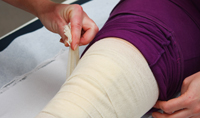Wound Treatment
Arterial ulcers
Arterial ulcers are caused by poor perfusion (delivery of nutrient-rich blood) to the lower extremities. Arteries are responsible for carrying nutrient- and oxygen-rich blood to the various tissues in the body. Ischemia, which refers generally to a restriction in the blood supply, can lead to arterial ulcers when it stems from a narrowing of the artery or damage to the small blood vessels in the extremities. The reduced blood flow then in turn leads to tissue necrosis and/or ulceration. The overlying skin and tissues are then deprived of oxygen, killing these tissues and causing the area to form an open wound. In addition, the lack of blood supply can result in minor scrapes or cuts failing to heal and eventually developing into ulcers.
Arterial ulcers are often found between or on the tips of the toes, on the outer ankle, or where there is pressure from walking or footwear. The wounds themselves are characteristically deep, often extending down to the underlying tendons, and will frequently display no signs of new tissue growth. The base of the wound typically does not bleed, and is yellow, brown, grey or black in color.
Often the limb will feel cool or cold to the touch, and the extremity will have little to no distinguishable pulse. The skin on the extremity will also appear atrophic, with hair loss on the affected extremity, while also taking on a shiny, thin, dry, and taut appearance. In addition, the base color of the extremity may turn red when dangled and pale when elevated. An additional sign of an arterial ulcer is delayed capillary return in the affected extremity.
These ulcers are generally very painful, especially while exercising, at rest, or during the night. A common source of temporary relief from this pain is dangling the affected legs over the edge of bed while sitting, allowing gravity to aid blood flow to the ulcerous region.
Arterial ulcers are distinguishable from venous ulcers in that venous ulcers are typically painless, and present with redness and edema (swelling) at the site of the ulcer.
